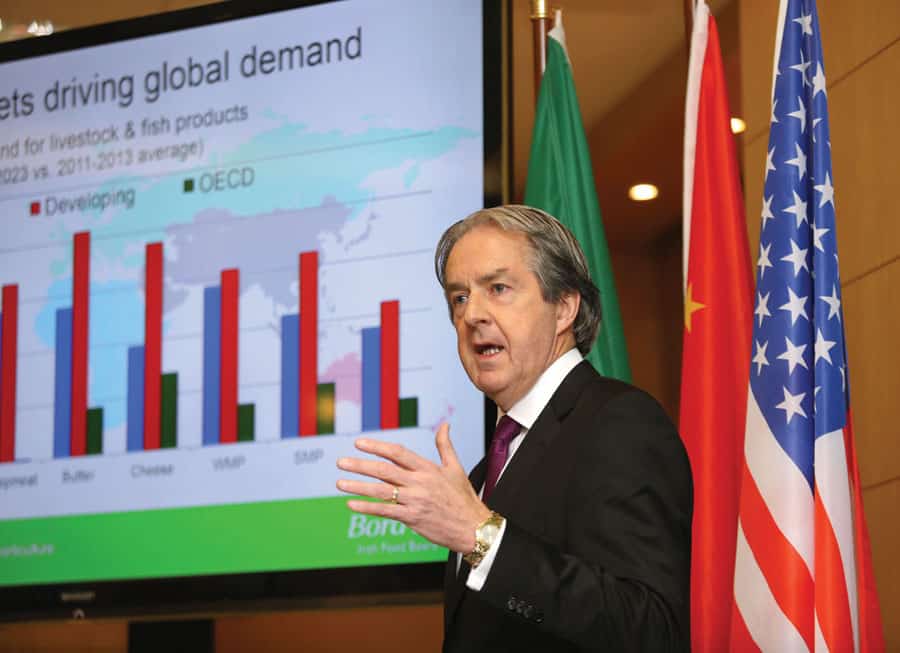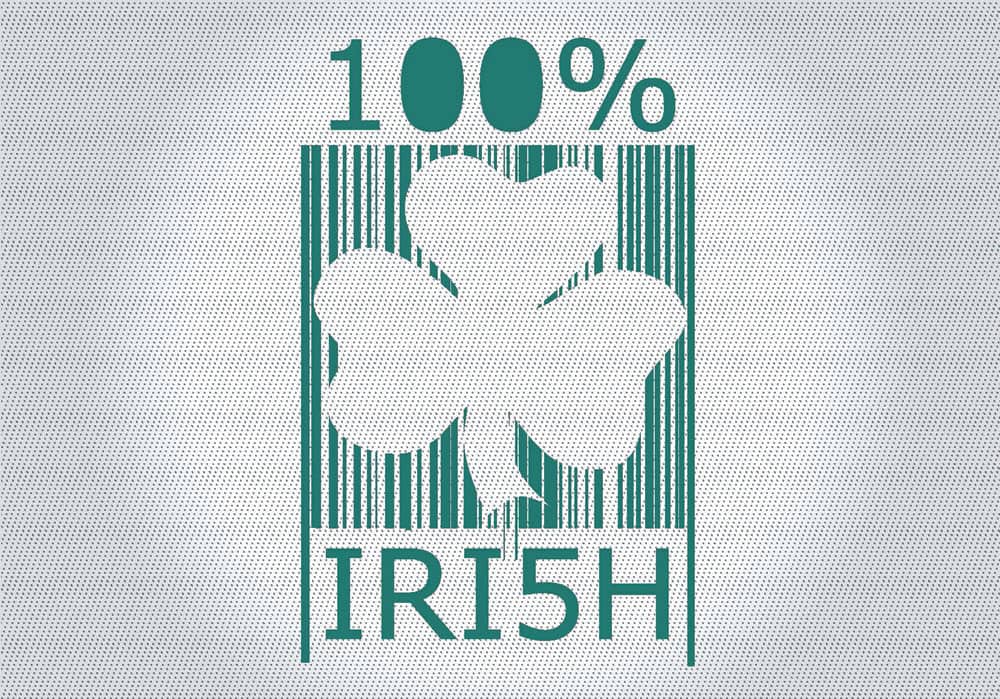Irish food and drink exports increased by 4% to reach €10.5bn in 2014, writes Niamh Mac Sweeney, as she examines performance prospects for the year ahead.
Export growth for the food and drink industry recorded an exceptional year in 2014. Exports grew by 4%, representing an expansion of 45% reaching a record high of almost €10.5bn. The strongest performing sectors were dairy product and ingredients which exceeded the €3bn mark (+3%), prepared foods (€1.8bn, +8%) and seafood (€540m, +8%).
Aidan Cotter, chief executive, Bord Bia outlined the background to the fifth consecutive year of export growth for the food and drink industry in January 2015 at the launch of Bord Bia’s Export Performance and Prospects Report.
Cotter highlighted the significant shift in the destinations for Irish exports in 2014 with international markets showing renewed growth, reflected in a 15% increase in trade to €3bn or 29% of total food and drink exports.
“The industry’s drive to broaden export reach to destinations outside of the EU is paying dividends with growth in emerging and international markets now driving export figures, offsetting the limited growth in our established premium EU markets,” he said.
Demographics
This shift in market destination was marked by increases in the value of exports to Asia to reach €850m (+45%) as well as significant increases to North America (€740m, +18%), the Middle East (€330m, +11%) and Africa (€610m, +9%). Within this, China recorded a further increase of almost 40% to reach approximately €520m. China is now Ireland’s second largest export market for dairy, compared to it position of 13th in 2008.
While it remains Ireland’s most significant export market, the share of exports destined for the UK eased slightly though the value showed little change at €4.2bn or 40% of export share. Stronger export values for beverages, prepared foods, mushrooms and poultry helped offset lower beef and dairy values.
China is now Ireland’s second largest export market for dairy, compared to 13th in 2008.”
Trading conditions
The value of exports to other EU destinations grew by 2% to reach €3.3bn equating to 31% of total exports reflecting largely static consumer price inflation across the eurozone.
Ireland’s exports benefited from the effects of a weak euro against sterling and the US dollar, however a strengthening euro against the Russian rouble, combined with trade suspensions, had a significant negative impact on Irish exports to that region with exports falling by an estimated 30% to €170m.
According to the Minister for Agriculture, Food and the Marine, Simon Coveney TD, said that since 2009 food and beverage exports have increased by 45% compared to Irish merchandise exports which are 5% higher. “Our strategy for exports is clear and our pursuit of the targets set out in Food Harvest 2020 is relentless. The speed and determination the industry displayed in shifting focus to new and emerging markets in response to static price inflation in EU markets, and the severe restrictions in the Russian market, has been remarkable.”

Aidan Cotter, chief executive, Bord Bia
Future prospects
The Bord Bia report also examines future prospects and opportunities. According to Cotter, there are a number of factors that suggest 2015 will be a more challenging year to maintain recent growth. “While the abolition of milk quotas in April 2015 is expected to lead to an increase in milk output of more than 10% for the year, the current weakness of global dairy markets is negatively impacting on price levels and recent forecasts from Rabobank suggest this trend will persist well into 2015,” Cotter explained.
Cattle supplies are expected to ease by more than 120,000 to 150,000 head in 2015, which will lead to export volumes falling by around 8%. However, some recovery in cattle prices is anticipated, although much will depend on demand in more established markets with consumer sentiment to remain a critical driver.
“The prepared foods and beverages sectors both face competitive market environments, although both have shown a strong ability to diversify over recent years,” Cotter said. “Further strong growth potential exists for whiskey in particular, while a number of key prepared food categories such as confectionary, ready meals and bakery are expected to record further growth.”
Bord Bia recently announced a new financial support, entitled the ‘Step Change Programme’, for small food, drink and horticulture businesses. The grant scheme is aimed at companies with a turnover between €100,000 and €5m, embarking on a new project to take their business to the next level. In 2015, Bord Bia expects the ‘Step Change Programme’ will benefit at least eight high potential Irish businesses with individual grants of up to €50,000. Tara McCarthy, Bord Bia’s director of Food and Beverages said: “This new enhanced grants programme has been designed to assist progressive small food, drink and horticulture companies to fund a significant project that will positively impact the company’s growth. Applicants must demonstrate new, innovative developments and activities, which will involve a considerable departure for the company.” Bord Bia’s existing financial programme, Marketing Assistance Programme, which provided 186 companies with a total of €976,000 in marketing grant aid in 2014, will operate as normal. For more information, visit: bordbiavantage.ie.
Promoting Irish food
Bord Bia has been to the fore in supporting and promoting the food and beverage industry both nationally and internationally. “We will continue to support the industry in its broadening of export reach and access to new markets to ensure that exporters can maximize their potential and hedge against market volatilities,” Bord Bia chairman, Michael Carey insisted. “The industry optimism emerging from our recent survey reinforces our efforts and I am confident that the recent market access to the US, and the potential access for beef to China, are reasons to look to 2015 with confidence.”
Beverage renaissance
In addition to food export growth, beverage exports were also up as a burgeoning Irish Whiskey (now considered the fastest growing spirit in the world with double digit growth) and craft beer sector played a vital role in driving sectorial growth.
Beverage exports were worth €1.2bn in 2014 with alcoholic beverages accounting for over 80% of beverage exports. This highlights the importance of beverage exports to the Irish economy.
Early indications suggest that exports in this industry will double by 2020 and double again by 2030. There are currently nine active distilleries in Ireland with eight more scheduled to open by the end of 2015.
Irish beer accounted for 19% of beverage exports with craft beer exports continuing to rise. There are currently 50 operational microbreweries with 40% of them currently exporting. This number is set to exceed 100 by 2020. According to Bord Bia, the growing number of brewers matched with developments among exporters will help drive renewed growth in the beer sector over the coming years.
Ireland exports beverage products to 125 markets worldwide with the UK, US, Canada, Germany and France taking the place of the top five markets. France is the fastest growing market, with Irish beverage exports increasing by 20% to €40m in 2014. There was strong emerging market demand in 2014 and key growth regions included Asia, the Middle East, South America and Africa.
According to DCU economist Tony Foley: “Bord Bia’s report confirms that 46% of beverage exports are sold in markets outside the EU with a value of €560m. The UK remains the largest export market accounting for 32% of beverage exports. The outlook for 2015 for beverage exports is broadly positive, driven by an anticipated further rise in Whiskey sales, the ongoing development of emerging markets and the ever increasing range of craft beers and spirits being produced in Ireland.”
Also commenting on the report, Peter O’Brien chairman of the Drinks Industry Group of Ireland (DIGI) said: “With some of the most celebrated and internationally recognised brands exported from Ireland, our drinks exports are clearly a national success story.”

